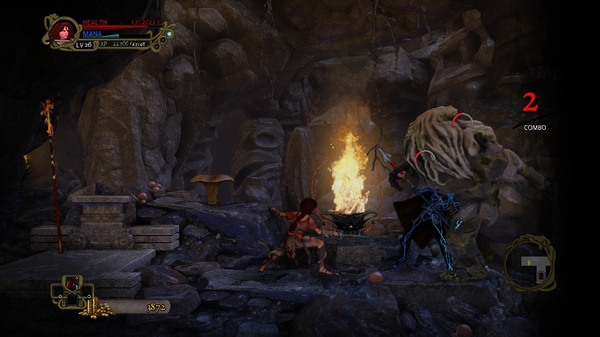
Marketing for Santiago, Chile-based ACE Team’s Abyss Odyssey claims the game has three genre lineages: roguelike, fighting game and platformer. But it’s not a platformer in the way that, say, Super Mario Brothers 3D World is a platformer. Think of the Castlevania games, where the jumping is more of a way of getting to your goal, rather than a demonstration of finesse in and of itself.
The fighting game traits: multiple characters with different moves and speeds. A good fighter, I think, is one where the controller and the game do very little to screw up what moves you want to do. The smaller the gap in both time and result between what’s in your mind and what happens on screen, the better the fighting controls. I’m not much of a fighting game player: My ability to switch my way of playing to match the strengths of the character I’m playing is pretty much nonexistent. My strategy is very much “hit buttons, wiggle joystick”, which leaves me unable to judge the efficacy of Abyss Odyssey’s fighting system.
Basically, I can’t tell if, after several hours of playing, only managing to get one six-hit combo (most of the time I maxed out at two or three hits) is the fault of the game or of me.
The game gives you the choice between three characters: a woman with a sword; what appears to be a faceless dude in a hood; and a dark-haired woman who shares a tailor with Lady Godiva and wields an axe that is taller than she is.
The first playable character, Katrien, is the dreamed embodiment of a warlock’s long-dead love. Fifteen seconds into the game, a solider shouts at her, “This is no place for a woman! Get out of here!” The invisible hooded dude is called Ghost Monk, and I’m not really sure how I unlocked him. The second time I started the game, he was available.
As you descend toward the sleeping Warlock, you fight through rooms of monsters, like a hyper-violent alarm clock. Make it to the bottom chamber and defeat the Warlock and you wake him up. But throughout most of the game, this results in a brief scene of your character overlooking the now-peaceful land with a warning that the monsters will return once the Warlock begins dreaming. He hits your snooze button.
This repetition is the influence of the third game genre, the roguelike—randomly generated enemy encounters, repeated dives into a space. Defeating the Warlock or dying sends you back to the beginning. You lose all carried items and weapons, but you keep your experience and collected gold.
Throughout the abyss are altars that you can activate as a checkpoint if you have a certain item in your inventory. Dying as one of the three characters finds them replaced with a Chilean soldier armed with a similar weapon. Get him to one of these altars without dying and you can resurrect your main character. If you die, then you go back to the checkpoint or the beginning.
All of the monsters that you fight can also be captured, allowing you to transform into the one you carry and fight with its attacks and special moves. Each form (monster, main character, soldier) has its own health bar. Managing these health bars is important to success in the fights. Entering certain rooms will have you fight as one of the monsters and, upon its completion, your main character will find an item that lets you be that monster.
In addition to monsters, you collect pages of the Warlock’s journal. Some of it is videogame menu-accessed lore: pretty typical how-this-situation-came-to-be backstory. Though, unlike most videogame fantasy, this lore is woven from the tales of Chilean, more than European, folk.
That naked axe woman is the Pincoya (who, by the by, is unlocked after you’ve thrown enough gold into a fountain in the abyss’s treasure room.) Wikipedia tells me that a pincoya is a spirit in indigenous Chilean folklore. You could think of her as a South American oceanid, if you need to constantly translate things into European terms.
It’s also presented as bits of the Warlock’s dream journal. Since the Abyss’s shifting structure and everything within it are dreamed into being by the Warlock, in a way it foreshadows what you’ll be fighting against.
But, like the skull-headed guitar player who offers advice in exchange for gold, these dreams don’t provide gameplay strategies. They’re not hint dispensers, tips and tricks built into the game’s code. Aside from the dream-explanation, very little of the game’s code structure is mirrored in its story layer—not much of one for that videogame version of Modern architecture’s truth-to-materials. But all those devices I mentioned, the different elements of different kinds of games stitched into this game, are its materials. And it does well with them.
And the story not being explicitly dictated by the mechanics? Well, in a medium where so much of the world-building-blocks and their masons skew European/American, Abyss Odyssey’s Chilean heritage is way more interesting material.
Abyss Odyssey was developed by ACE Team and published by Atlus. It is available for Xbox 360, Playstation 3 and PC.
Brian Taylor didn’t even mention the parts where a demonic Paganini shows up and plays a violin at you.
